Some of these are probably more subalpines, but what the heck ;D
Tried to post once, unsuccessfully, hopefully wont end up with a double..
Rick asked about the plant behind a Sempervivum in another thread,
1,2 Polemonium boreale these are from seed spring 2012, so yet to overwinter; I have them planted in a couple of spots to see what they like..
3-5 Potentilla nitida with frost; I have a number of seedlings, some have been in ground since last fall, others only planted out this year; there is interesting variation in leaf colour, density etc..
6 A couple of Townsendia parryi trying to flower, can't see these ones will make it, though there is another in a different bed by the house that is open..
7 Next to the Townsendia is an Erigeron, collected in the mts west of here, which I've been calling compositus, but wonder if that's right? of course this is no pic for id... frosty morning..
Comments
Re: Alpines October 2012
Thanks, Anne! They are already favourites of mine.. I just hope they flower here, Tim mentioned them being shy to flower in cultivation..
Re: Alpines October 2012
Cohan, Polemonium boreale seems to be a nice plant. I have never tried it but P caeruleum is native here and is very good at our mountain cabin.
I have not tried Potentilla nitida either but your place should be more homely for it than Tim's ;) I remember seeing it in the Alps several years ago.
Although the Townsendia don't reach to open the flowers now they should survive the winter. At our mountain cabin even lateflowering dandelions survive!
Re: Alpines October 2012
There is a picture on the net of Polemonium boreale- I think it's on Svalbard- all alone on gravel plain- very dramatic!
I have my fingers crossed for flowering on the Potentilla- maybe next year! It certainly feels like the alps here- we could have 2-5cm of snow today with a high of 0C, but back up to mid-teens C by the weekend!
I still have to post pics of the Townsendia that did open- not quite flat open, but close..
Re: Alpines October 2012
Some more seedlings from this spring, planted out in late summer- these are some more I expect to get a little tall- mostly in flower/seed so I've given them a berm behind a rock garden; this berm was part partially decomposed sod mixed with topsoil and clay and a bit of gravel in the top few inches. Plants are those coming from alpine/sub-alpine meadows etc; this is in a part of the property that stays moist, yet I hope for the raised aspect to provide good drainage while the plants can send roots down to the moister zone if they want-- those are the aspirations, time will tell! Planting was done in late summer 2012
1,2 Hieracium villosum seedlings from spring 2012, this was our frosty morning last week, but the sun had already hit this spot and melted it..
3 one of a number of Pulsatilla on the same berm; these are older, but languished a couple of years in pots, waiting for a bed! I have seedlings from garden seed of alba, rubra, rosea; we'll see if they flower true to type, but the leaves at least are different!
I also stuck some seedlings of Cyclamen purpurascens from Austrian wild seed, in a few spots on this berm; their seedmates have survived one winter (and one flowered) on the rock garden beside this, so I thought I'd let some see if they like a less rocky life..
Re: Alpines October 2012
Another of the Townsendia parryi mentioned above- this was planted out late summer 2011, and grew well all summer this year. the flower is still more or less trying to open, though not doing much today with a high of 0! this bed is right in front of (though not up against) the house, so one of the warmest spots in the yard, and one of the sunniest.. this is the same bed with my no-name Sempervivums..
Re: Alpines October 2012
Back to the berm above, continuing on the dandelion-esque theme of Hieracium,
1 Hieracium intybaceum (most of the leaves still probably the slightly stretched out leaves from the seedpot)
2 Hypochoeris maculatum no marks yet, leaves are still tiny, but pleasingly flat
3 Still Asteraceae, but not dandelions! Saussurea riederi (I'll post in the Sauss thread too, for completeness- I imagine those family/genus threads will be more useful for future members to search in than these generalist threads); interestingly, this should be a taller Sauss compared to the several low rosette species, yet this spring's seedlings are still tiny compared to the S nepalensis in the next post..
4 another of the Pulsatillas (or the same one? lol these shots are from a different day- a couple days after the coldest nights/frost, and plants look unfazed..
Re: Alpines October 2012
In the actual rock garden next to the above berm,
1 Geum montanum from spring 2012 seeds, planted out late summer.. these are still tiny- the whole thing maybe an inch across..
2 Saussurea nepalensis these still have long stemmed leaves from the seed pot, where they were in part sun and so packed in the pot they had to reach for light!
Re: Alpines October 2012
Great to see the "fruit of your labours" finally, Cohan, knowing you've been busy all summer building rock gardens! It's all looking really nice!
Re: Alpines October 2012
There is a picture on the net of Polemonium boreale- I think it's on Svalbard- all alone on gravel plain- very dramatic!
I'm going to visit Svalbard next summer. I'll tell you if I do see any P boreale!
Interesting plants you show, Cohan! Hypochoeris maculata is native here but I have never considered it as a rockery subject ;D Especially the leaves can be nice though.
Re: Alpines October 2012
Thanks, Lori- I will get around to showing some overviews eventually so you can all see what I've managed so far....lol I'\ve taken pics at various stages, so I'll need to do a compilation...
Trond- the most important plant for me on Svalbard is a white/pale flowered dandelion- so please watch for any in seed ;D
I don't think any of these dandelion cousins will have very exciting flowers, plus tallish flower stems, so that's why I put them on the berm behind the rock garden- where I can enjoy the foliage and they won't overwhelm any little delicate things :)
Re: Alpines October 2012
Orostachys iwarenge has had enough time, in this warm summer and very extended fall, for the flowers to open: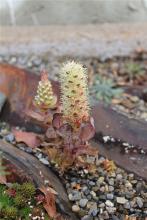
Jovibarba hirta (or so I assume) in fall colour: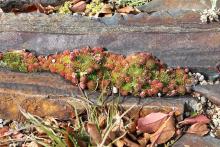
Re: Alpines October 2012
Stunning photographs of some amazing plants, Lori ... thanks so much for posting.
Re: Alpines October 2012
Thanks, Cliff!
With them blooming in the second year from seed or even the first, it doesn't look like I'm ever going to get much of a plant of Orostachys iwarenge going! Well, it's nice to see it get to bloom, on the other hand.
More from the rock garden, just foliage... Edit: all are from seed this year, unless otherwise indicated:
Aethionema schistosum, a division purchased at the CRAGS sale this spring (thanks, Cathy!):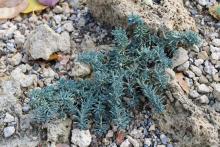
Sideritis clandestina, with Lactuca intricata in the background: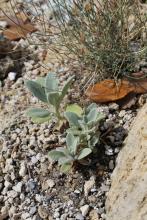
Campanula topaliana... unfortunately monocarpic: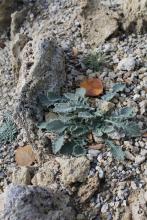
Eriogonum sp., with Lupinus wyethii (purchased from Beaver Creek this spring) in background: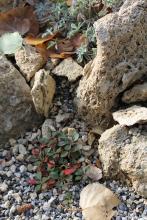
Arabis androsacea, draping nicely (grown from seed in 2010):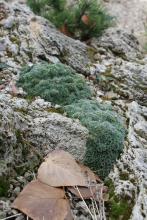
Marrubium lutescens: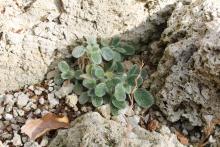
Re: Alpines October 2012
2 Saussurea nepalensis these still have long stemmed leaves from the seed pot, where they were in part sun and so packed in the pot they had to reach for light!
Your Saussurea nepalensis looks like the one I grew in 2009: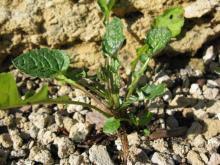
I think it was from a seedex though I am relying on my dim memories. (Unfortunately, none of the seedlings wintered over. I didn't get to see the bud shown in this photo in flower either.)
The Saussurea nepalensis I grew this year is also from a seedex and looks totally different: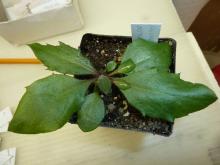
Will the real Saussurea nepalensis please stand up? ;D
Re: Alpines October 2012
Great stuff, Lori- loving all the Labiatae!
The Arabis really is getting some nice drape- how old is it? The Inula and Orostachys are excellent!
My Saussurea nepalensis seed was from Philippe, at the alpine botanical garden in France whose name I will need to make a point of remembering..lol, but I don't know what his/their original source was.. Hope mine will winter over...
Re: Alpines October 2012
Lori - you seem to grow all the plants I love growing (silvers and greys) but in a much better setting! I must discover a source of tufa. Do you protect any plants over winter? Or are winter snows persistant enough to do this? Our winters tend to be mild and soggy, with very occasional snow and I cover quite a few plants. A great future project would be a 'tufa cliff' (Roy Elliott made one these years ago, with a cantelivered canopy, and grew some amazing plants in it).
Re: Alpines October 2012
My Saussurea nepalensis seed was from Philippe, at the alpine botanical garden in France whose name I will need to make a point of remembering..lol, but I don't know what his/their original source was.. Hope mine will winter over...
Yes, I think the one you are growing (and I grew in 2009) looks more likely...
On the other hand, it seems like the genus has an amazing range of leaf forms! After growing Saussurea nupuripoensis this spring (from Holubec seed, so I assume it's correct) (on the left below) and Saussurea eopygmaea previously (from Pavelka seed), shown on the right below, I'm not too sure what might characterize Saussurea foliage! ;D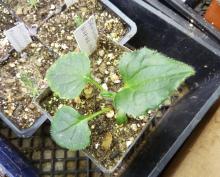
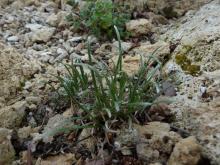
Tim, most of these plants were just grown from seed this year, so come next spring, I may well find the odd one that did not winter over for whatever reason. I don't normally protect any plants outdoors though... I'm really only interested in plants that will be hardy without any particular fussing by me. A possible difference between here and there is that protecting plants here is usually to insulate them against cold, whereas there, given soggy winters, it sounds like keeping water off might often be purpose for covering them (given that you are in so much milder a climate, compared to zone 3, that "cold hardiness" must be less of a concern). Having lived/gardened in this same place for 16 years now, it seems the norm used to be very sporadic and inconsistent snow cover, with the usual periods of snow melt and exposure caused by chinooks. The last 3 winters have been much snowier though, with much more consistent snow cover... not sure that this has been a particular advantage IMO. (Last winter was quite hard on many plants that had been growing happily for years, despite the supposed advantage of snow cover.)
Love those tufa cliffs and walls! I wonder if anyone has done one here? Without hearing of any local experiences, I suspect to have one here, in this dry climate, might require some sort of watering system... or else a lot more attention than I'm likely to provide... ;D ;D
Re: Alpines October 2012
Lori- I think you are right that Saussurea foliage would be rather hard to typify- some have compound leaves, many others entire, with our without toothing, etc.. I like the one you show with linear leaves..
As for tufa towers, besides issues of water, I wonder about issues of exposure in winter for such a structure in colder climates? In fact, I'm a bit nervous about some spots on my new rock gardens, as I built them a bit steep/high to try for greater drainage without exceptional materials.. not too much planted at the peaks of all of them yet, time will tell if those spots have any more winter difficulties..
Re: Alpines October 2012
Lots of interesting plants, everyone! Lori, that Campanula topaliana would sure be a genus stumper. Mark would love that one.
Late blooming species always seem to surprise me with their "hurry up" growth so late in the season when I think there is never enough time to mature. Such a plant seems to be Orostachys iwarenge for me.
23 September 2012 1 October 2012
I have no idea what well grown seed capsules should look like. Do they seem like they will have viable seed?
Re: Alpines October 2012
I've never seen mature seed capsules on this species but assume they're not very different from the ones of other Crassulaceae ;) It's a nice plant by all means, hope you get seed!
Re: Alpines October 2012
Little bits of fall colour in the rock garden...
Eriogonum caespitosum, bought from Beaver Creek last year: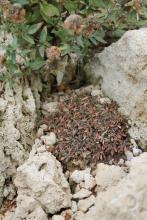
This year's seedling of Dryas drummondii: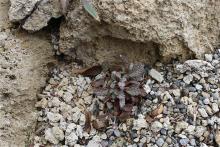
Aethionema saxatilis ssp. oreophila, showing what is likely to be one of the last flowers in the rock garden: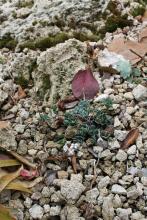
Re: Alpines October 2012
This is a tremendous form of Geranium xlindavicum, called 'Gypsy', bred by that great partnership Eric Smith and Jim Archibald at The Plantsman Nursery. It is a cross between 'Lissadell', a paler form of x lindavicum, and the vivid cinereum ssp. subcaulescens. Unfortunately it is slow and tricky to propagate, but I have thoughts of chopping the plant off at ground level and hoping it will produce multiple new crowns that can be separated. First I must get a second plant growing well as insurance!
Re: Alpines October 2012
Rick- I don't know how long it will take to ripen, but know Orostachys in general are very late.. seed capsules I'd expect not to look like much..
Lori- nice fall colour- the Dryas is looking big for one year!
Time- looks like a really nice colour and markings on the Geranium..
Re: Alpines October 2012
Interesting geranium, Tim... what very finely dissected leaves.
I hadn't even heard of the hybrid name before. I found one site that says G. x lindavicum is a cross between G. cinereum (as you mentioned) and G. argenteum... is that your understanding?
Re: Alpines October 2012
Lori - sorry I'm afraid the photo tricks the viewer, the leaves are actually from a euphorbia seeding in the bed. But yes the hybrid name x lindavicum is cinereum x argenteum. I've had the latter once or twice but never managed to keep it going - in fact I haven't been hugely successful with many of these small geraniums. 'Gypsy' is growing in a pure sand trough, but very slowly! Just out of interest here are the leaves of G. lasiopus (which must be close to cinereum and argenteum). I bought this from Blackthorn Nursry last year but it hardly seems to have grown at all.
Re: Alpines October 2012
Exceptionally beautiful flower on that Geranium x lindavicum. Hope someone will take notice and try to breed for ease of culture.
Charles Massachusetts USA
Re: Alpines October 2012
A couple of entries from our recent Alpine Garden Club show.
Best exhibit--Androsace sarmentosa
and another one,winner in it's class-- Androsace vandellii.
Cheers Dave.
Re: Alpines October 2012
Lori - sorry I'm afraid the photo tricks the viewer, the leaves are actually from a euphorbia seeding in the bed.
Oops, I should have realized the leaves were not a geranium at all... :-[
Geranium lasiopus has beautiful foliage.
Wonderful photos from the alpine show... I have to admit that I still find the concept of growing plants permanently(?) in pots sort of odd, but I'm warming up to it... ;)
Re: Alpines October 2012
Great Andros, Dave!
I could see growing in pots if winter deep freeze weren't an issue-I have to sink all the pots here- always seem to have leftover seedlings etc!
all safely sunk some time ago.. 15C now, but next six days all forecast to be -1 to -3C daytime!
Re: Alpines October 2012
Wonderful photos from the alpine show... I have to admit that I still find the concept of growing plants permanently(?) in pots sort of odd, but I'm warming up to it... ;)
Thanks Lori
The Androsace were entered from an alpine nursery owner--they may well be her 'stock 'plants . They can be grown outside here in our climate however i find A.vandellii doesn't like my shady wet conditions in winter.... :'(
I admit to having a few plants in pots --far too many :-[ :-[ --mostly duplicates of easy bulbs that grow well in the garden--however a number are more specific and need to be under cover in winter as an aid to control moisture levels---i find pots easier for photographing -For all of the above though, the main reason is that my garden is 'chocka block',(full),and i haven't yet resolved the battle between purchasing plants/sowing seed verses lack of space--although that day is not far ahead .... ;D
Cheers Dave.
Re: Alpines October 2012
Great Andros, Dave!
I could see growing in pots if winter deep freeze weren't an issue-I have to sink all the pots here- always seem to have leftover seedlings etc!
all safely sunk some time ago.. 15C now, but next six days all forecast to be -1 to -3C daytime!
Thanks Cohan ---15c would be nice :)--our neighbour informed me this morning we had 11 straight days of rainfall--although i did notice an yellow ball in the sky this afternoon ........ :o
Cheers Dave.
Re: Alpines October 2012
See my post from this morning in garden walks-- all is white now!..lol Probably be a while before we see 15 again (actually got to 17/18)..
I can also relate to having things in pots because there is nowhere else to put them- I had my sempervivums in nursery pots for a couple of years before I built beds for them, and by that time they'd already multiplied to the extent I couldn't fit them all in the beds! Other seedlings etc are also waiting for spaces to be prepared for them, that's why this year I spent the whole summer building beds...
Re: Alpines October 2012
I still have a fair number of flowers open in the garden since we have yet to have a frost. Primula saxatilis is in full bloom...not good!
Re: Alpines October 2012
Ipomopsis aggregata is one of our striking native plants in the dry interior of British Columbia. I grew some from wild seed collected in 2011 and sown last winter. This one produced a large flower spike in October, about 9 months from germination.
Re: Alpines October 2012
Todd- hope your inevitable cool down isn't too sudden! Love the Croci you've shown- I have yet to try any fall bulbs, but I think I'm liking the Crocus in general more than the Colchicums..
David- the Ipomopsis is very nice! I've looked at this or similar on Alplains list, I think...
Re: Alpines October 2012
David, is Ipomopsis aggregata perennial? A plant I wish to try!
Todd, I think I should have grown my autumn Crocuses in pots as the ones I have outside is always damaged by the strong rain :-\
Re: Alpines October 2012
Trond:
Unfortunately Ipomopsis aggregata is monocarpic though there are reports of occasional repeat flowering in the garden. Apart from the striking flowers it is also worth growing for the foliage which forms a large fern-like rosette.
Re: Alpines October 2012
Trond:
Unfortunately Ipomopsis aggregata is monocarpic though there are reports of occasional repeat flowering in the garden. Apart from the striking flowers it is also worth growing for the foliage which forms a large fern-like rosette.
Thanks David! Have to look out for seed, hopefully some appear in the seedex.
Re: Alpines October 2012
A couple of nice ones - Ranunculus haastii - taken in situ by friend, Chris Smart, Geography professor, who is on his sabbatical in New Zealand at the moment. He is not a member. I have tried to grow this from seed several times but no luck at all. Fran
Frances Howey
London, Ontario, Canada
Zone 5b
Re: Alpines October 2012
A couple of nice ones - Ranunculus haastii - taken in situ by friend, Chris Smart, Geography professor, who is on his sabbatical in New Zealand at the moment. He is not a member. I have tried to grow this from seed several times but no luck at all. Fran
Frances Howey
London, Ontario, Canada
Zone 5b
Wow! While in bud that ranunculus looks like an alien lifeform! :o
Re: Alpines October 2012
Agreed!
Now you're going to have competition for the seed...
Re: Alpines October 2012
Awesome, Fran! Thanks for sharing this beauty
Re: Alpines October 2012
That ranunculus reminds me of a winter aconite more than a buttercup!



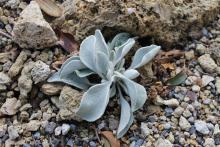
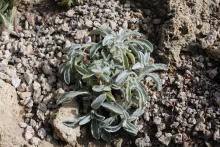
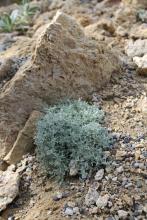











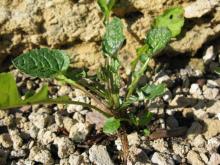
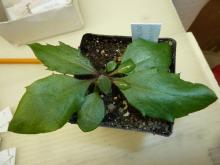
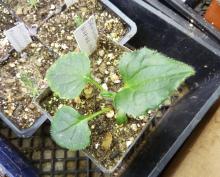
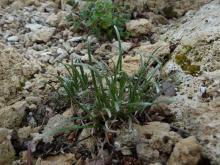
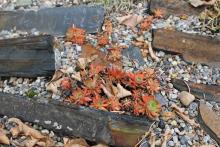



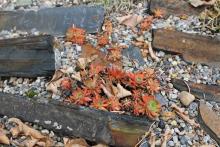
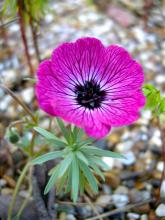
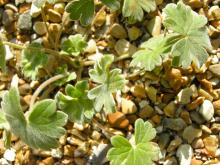
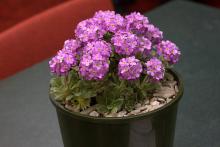
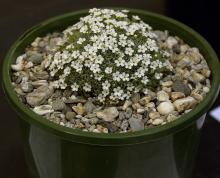
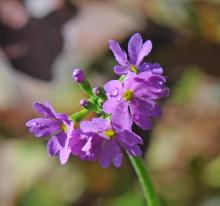
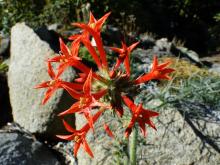
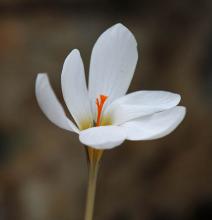
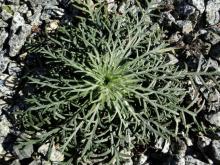
Cohan, great pictures of the Potentilla nitida. The frost makes the foliage even more beautiful.